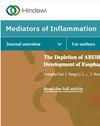Abdominal Aortic Occlusion and the Inflammatory Effects in Heart and Brain
IF 4.4
3区 医学
Q2 CELL BIOLOGY
引用次数: 0
Abstract
Background. Abdominal aortic occlusion (AAO) occurs frequently and causes ischemia/reperfusion (I/R) injury to distant organs. In this study, we aimed to investigate whether AAO induced I/R injury and subsequent damage in cardiac and neurologic tissue. We also aimed to investigate the how length of ischemic time in AAO influences reactive oxygen species (ROS) production and inflammatory marker levels in the heart, brain, and serum. Methods. Sixty male C57BL/6 mice were used in this study. The mice were randomly divided into either sham group or AAO group. The AAO group was further subdivided into 1–4 hr groups of aortic occlusion times. The infrarenal abdominal aorta was clamped for 1–4 hr depending on the AAO group and was then reperfused for 24 hr after clamp removal. Serum, hippocampus, and left ventricle tissue samples were then subjected to biochemical and histopathological analyses. Results. AAO-induced I/R injury had no effect on cell necrosis, cell apoptosis, or ROS production. However, serum and hippocampus levels of malondialdehyde (MDA) and lactate dehydrogenase (LDH) increased in AAO groups when compared to sham group. Superoxide dismutase and total antioxidant capacity decreased in the serum, hippocampus, and left ventricle. In the serum, AAO increased the level of inducible nitric oxide synthase (iNOS) and decreased the levels of anti-inflammatory factors (such as arginase-1), transforming growth factor- β1 (TGF-β1), interleukin 4 (IL-4), and interleukin 10 (IL-10). In the hippocampus, AAO increased the levels of tumor necrosis factor (TNF-α), interleukin 1β (IL-1β), interleukin 6 (IL-6), IL-4, and IL-6, and decreased the level of TGF-β1. In the left ventricle, AAO increased the level of iNOS and decreased the levels of TGF-β1, IL-4, and IL-10. Conclusions. AAO did not induce cell necrosis or apoptosis in cardiac or neurologic tissue, but it can cause inflammation in the serum, brain, and heart.腹主动脉闭塞与心脑炎症作用
背景。腹主动脉阻塞(AAO)是一种常见的腹主动脉阻塞,可引起远端器官缺血/再灌注(I/R)损伤。在这项研究中,我们旨在研究AAO是否会引起心脏和神经组织的I/R损伤和随后的损伤。我们还旨在研究AAO缺血时间的长短对心脏、大脑和血清中活性氧(ROS)产生和炎症标志物水平的影响。方法。本研究选用60只雄性C57BL/6小鼠。将小鼠随机分为假手术组和AAO组。AAO组按主动脉阻塞时间进一步细分为1 ~ 4小时组。根据AAO组的不同,夹住腹主动脉1-4小时,然后在取下夹后再灌注24小时。然后对血清、海马和左心室组织样本进行生化和组织病理学分析。结果。aao诱导的I/R损伤对细胞坏死、细胞凋亡或ROS的产生没有影响。然而,与假手术组相比,AAO组血清和海马中丙二醛(MDA)和乳酸脱氢酶(LDH)水平升高。血清、海马和左心室超氧化物歧化酶和总抗氧化能力下降。在血清中,AAO提高了诱导型一氧化氮合酶(iNOS)水平,降低了抗炎因子(如精氨酸酶-1)、转化生长因子-β1 (TGF-β1)、白细胞介素4 (IL-4)、白细胞介素10 (IL-10)水平。AAO使海马组织中肿瘤坏死因子(TNF-α)、白细胞介素1β (IL-1β)、白细胞介素6 (IL-6)、IL-4、IL-6水平升高,TGF-β1水平降低。在左心室,AAO升高iNOS水平,降低TGF-β1、IL-4、IL-10水平。结论。AAO不会引起心脏或神经组织的细胞坏死或凋亡,但会引起血清、脑和心脏的炎症。
本文章由计算机程序翻译,如有差异,请以英文原文为准。
求助全文
约1分钟内获得全文
求助全文
来源期刊

Mediators of Inflammation
医学-免疫学
CiteScore
8.70
自引率
0.00%
发文量
202
审稿时长
4 months
期刊介绍:
Mediators of Inflammation is a peer-reviewed, Open Access journal that publishes original research and review articles on all types of inflammatory mediators, including cytokines, histamine, bradykinin, prostaglandins, leukotrienes, PAF, biological response modifiers and the family of cell adhesion-promoting molecules.
 求助内容:
求助内容: 应助结果提醒方式:
应助结果提醒方式:


